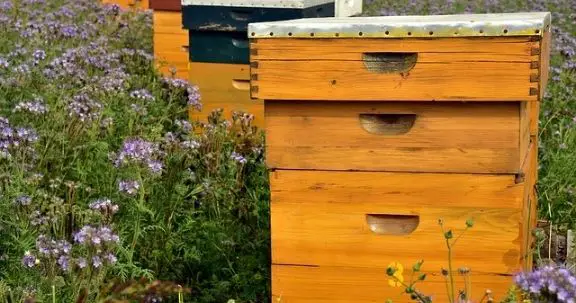Would you like an inexpensive beehive that you could build at home and work without a lot of back strain? Kenyan and Tanzanian top bar hives each consist of a horizontal cavity with strips of wood called top bars that form the roof. The bees live in the cavity and build their comb off of the top bars. A cover usually goes over the top bars to keep out the weather and reduce temperature fluctuations.

Although these hives originated in ancient Greece, they are often used in East Africa due to their low construction cost. Some beekeepers believe that this hive style may be more suited to hot climates and bees that swarm often (African bees) than to colder climates with European honey bees, but there are beekeepers in Maine, the USA, and Canada who successfully keep bees in them.
There is a difference between the two: Kenyan top bar hives have slanted sidewalls and Tanzanian top bar hives have straight sidewalls. The Kenyan style is more common in the US as the comb is reputed to attach to the walls less than in a Tanzanian hive, but that’s debatable. (Most states and localities in the US want hives with inspectable frames. Research your local beekeeping laws before you invest in one of these hives.)
- inspections are less invasive – only the comb being removed and its immediate neighbors are exposed to light and temperature changes = less stress for the bees
- costs less than a Langstroth hive, much less if you build it yourself
- may have fewer pests such as small hive beetles because fewer nooks and crannies for the beetles to hide from the bees
- much easier on the beekeeper’s back than the vertical hives (Lanstroths and Warrés) – people who aren’t as strong, who have back pain, or are handicapped are more likely to be able to use this hive long term – you only have to lift off the cover and manipulate individual combs
This is a honey extractor with frames in it (not top bars): honeycombs are spun, honey flings out and drops to the bottom & runs out a spigot called a honey gate.
- some beekeepers report that they can slowly hand crank a top bar with an attached comb in a honey extractor and preserve the top bar with wax comb for the bees to reuse (see the post on Langstroth’s pros and cons to read about the advantages and disadvantages of reusing comb)
- crush and strain honey extraction is low tech and keeps wax and its chemicals cycling out of the hive
- small amounts of honey can be harvested frequently
- bees build whatever cell size they want, more natural
- little equipment to store
- some experienced KTBH beekeepers report honey production equal to Langstroths
Kenyan or Tanzanian top bar hive Cons
When you remove 1 top bar/comb, you can see how just that comb and the neighbors are exposed to light. The rest of the hive remains sealed.
- more difficult to find a mentor
- Easier to damage comb without a frame supporting it collecting honey or doing hive inspections
- when installing packages of bees, there may be a higher rate of absconding (all bees leave the hive) than with a Langstroth hive
- maybe more difficult to overwinter because bees may have more trouble moving horizontally to reach the honey when the weather is cold
- most beekeepers will get less honey production than with a Langstroth hive
- crush and strain make the bees build more comb which is expensive for them in time and resources
- small amounts of honey may need to be harvested frequently
- requires more frequent visits than the Langstroth hive to keep new comb growing in alignment with the top bars and not crosswise, to cut comb attachments from the walls, and to keep the hive from becoming overcrowded
- can be more difficult to treat varroa mites than a Langstroth
- can be more difficult to winter feed than a Langstroth